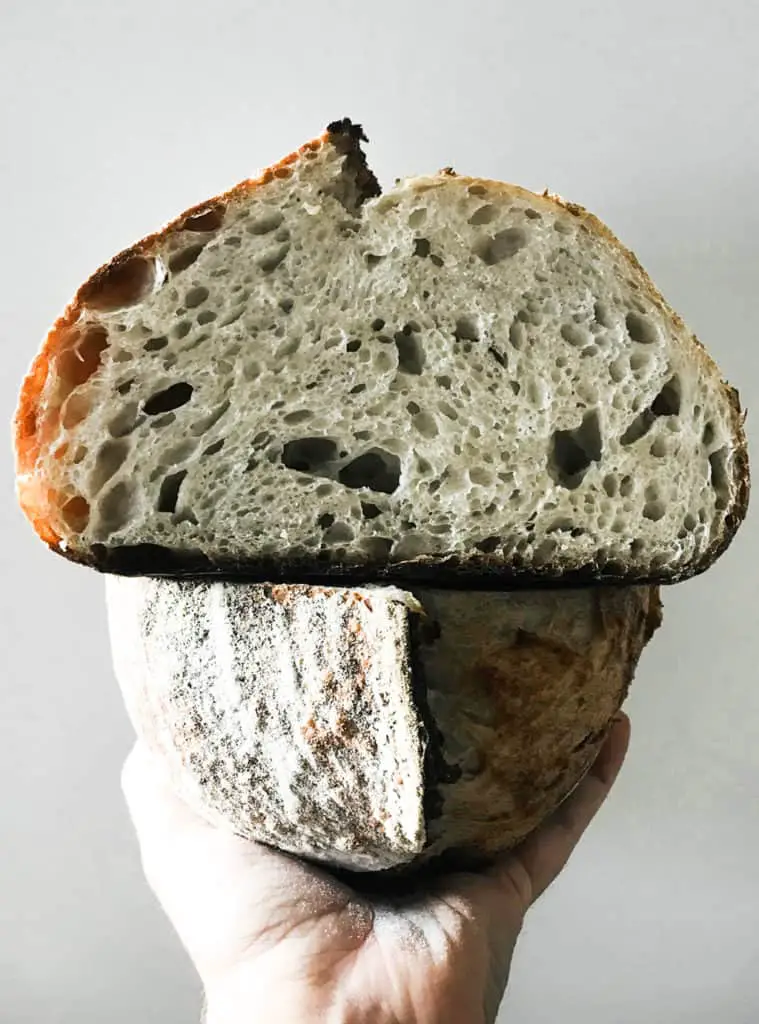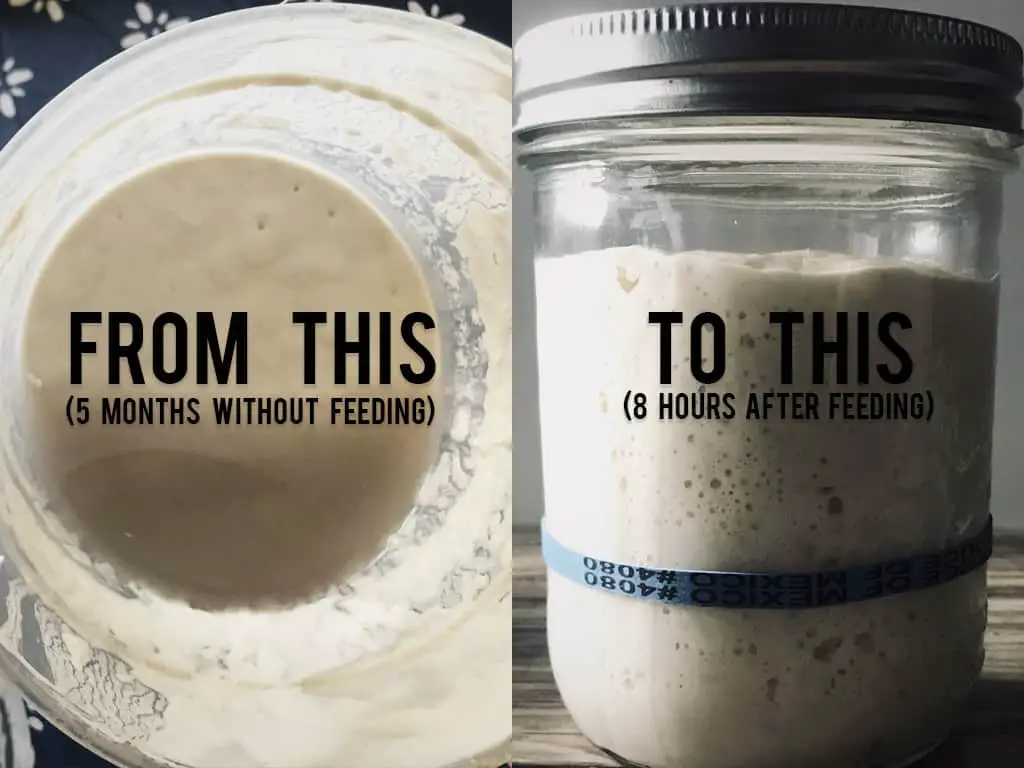*Note that this post is intended to discuss the longevity of sourdough starter cultures, it is not a food safety recommendation. Please use your best judgment in handling foodstuff. 🙂
As legend has it, sourdough starters never die. We’ve even heard stories about 20 to 40-year-old starter cultures being “revived” after just a single feeding. That is incredible! However, legends are often hyperbolic and probably more often than not are just flat out false. So we wanted to dig into this subject a bit and do a little experimenting for ourselves.
In all honesty, we’ve not been baking for 40 years, let alone 20, so we’re not going to be chiming in on those outlandish numbers, but we doubt you’re here because you are asking if sourdough can last 40 years. What you’re likely wanting to know is how long you can go without feeding your starter before it dies out. And you’re likely wondering if you can go for a few days, a few weeks or a few months. Maybe a few years.
How often do you really need to feed sourdough? Sourdough starter is surprisingly resilient and can easily last months without being fed when proper storage principles are used. This means the length at which a starter will remain viable has to do with how it is handled and stored. Thankfully, for the home baker there are some very simple methods that will get you months of storage, and with just a little extra effort, even years. Let’s touch on some of the caveats associated with keeping a starter alive between extended breaks in feedings.
Storing Sourdough Starter
We’ll stick to the three most common storage methods: in a jar on the counter, in a jar in a fridge, and dehydrated starter in an airtight jar or bag. Let’s touch on the counter regime first, which gives the shortest window before problems can develop, then we’ll move on to the fridge which buys quite a bit more time, and after that, we’ll discuss dehydrating for even more time between feedings.
On The Counter
We’ll keep this one short, as it really isn’t a viable option for keeping a starter unfed for an extended amount of time. You can really only let it sit for a day or two without feeding before you start to run into problems. In our opinion, the only reason to keep a starter on the counter is if you bake every day. We have found no difference in activity and flavor between counter and fridge storage.
After just a couple of days without feeding, you’ll likely see that your starter is a bit sluggish after it’s next feeding. You’ll certainly be able to get it back to normal after a second feeding, but that isn’t the major issue. The biggest issue we notice is mold. Mold is far more likely to grow while being left out at room temperature. Without movement from regular refreshing happening, the chances of mold setting in are quite high for storage purposes. Which is why after just a few days we see mold setting in for us. This isn’t like clockwork, it doesn’t happen every third day, but there is a higher probability that it can and will than with other methods.
In The Fridge
As for the fridge, you have about a week before it starts to slow down. Which makes it perfect if you bake once or twice a week (this is where we fall). You’ll be able to find a rhythm of never needing to feed your starter until you want to bake. Win! But if you go over a week, you’ll need to feed your starter once or twice before using it again. Not because it is bad, but because it is less active. One or two feedings is all it needs.
Now, even though it can go much longer and survive doesn’t mean it should be routinely fed every 6 months or so. We would set a limit at a month without feeding or checking in on a starter. Every two weeks would likely be better. But, not because we are nervous it will die out, our little 5-month test (and others in the past) have us convinced these things are fighters when given the advantage of fridge storing. The concern for us, like with the counter storage regime is mold and food safety. So, if you stretch out long breaks of a month or more between feeding, we’d also suggest cleaning your jar each time you store it away. Unlike our experiment, where we purposefully put it away a hot mess, the cleaner the jar the better.
In short, keep the jar clean and check on the thing every once in a while, but you should certainly be able to go several months without killing the cultures in your starter. Obviously use your best judgment, if you think it’s bad then start over. No need to prove (I so badly wanted to say “proof”) anything here. Your health is more important. If it smells funny, looks funny, or you just have second thoughts…start a new batch. We are in no way telling you that your starter will be perfectly safe to use 5 months from now, but the cultures will likely be active and alive.
If you know you want to go a long time without using a starter, we’d say it might be worth dehydrating some of your starter. It will literally last for years (yes even 40 seems to be possible).
Dehydrating Starter
We’ve never dehydrated our starter, and honestly, unless we start selling our starter, we probably won’t go this route. But, for a little added insurance for those of you that are concerned or attached to your starter, or if you hated the process of starting your own, this is for you.
Since we’ve never done this before, we won’t attempt to give you the instructions. There are plenty of resources online from folks that have done it and are more knowledgable than us. This one over on King Arthur is very detailed: https://www.kingarthurflour.com/blog/2015/05/01/putting-sourdough-starter-hold.
The only thing we really disagree with is the author’s suggestion of dehydrating if you’re going to go longer than a couple of weeks. As stated above, the fridge is our recommendation unless you know you won’t be baking anytime this year. We’ve gone months, multiple times, without any issues. The worst we’ve seen is no activity for the first 10-hour window after feeding. But everything was golden after that. In fact, the images in our thumbnail are from that same sleepy starter. We put it back in the fridge right after that first test. This time around, after 5 months of no feeding it took just 4 hours to double in size, and 8 hours to triple. Not bad!
But, again, maybe you just need added security because losing your starter would be a major blow. In that case, the dehydration method will give you years of worry-free storage.
How To Revive A Sleepy Starter
If you’ve made it this far, you’ve probably picked up on our bias. We love the fridge! So, our tips for reviving a sleepy starter will be geared for those coming out of the fridge. Let’s dive in.
There Will Be Hooch

The first thing you’ll likely see is hooch (liquid) on a starter that has gone for more than a couple of weeks, maybe even as little as a few days. It’s perfectly fine and nothing to worry about. It just lets you know that your starter is hungry. Even though many folks stir it right into their starter, we find better success in pouring the hooch out before feeding.
There Will Be Need For Conservation

We like to mix just a little bit, only about 30 grams of the old starter into 50 grams of flour and 50 grams of water for the first feeding. Put the remains of the old starter back in the fridge just in case this new batch doesn’t turn out. Using less starter will help things progress much better than if you used all of it.
This has to do with food supply. Less starter with more feed ensures the poor starving thing gets enough to eat. 🙂 Don’t make the mistake of thinking it needs more starter to have a fighting chance. It needs food. Think of it as a teenager. 🙂
There Will Be More Than One Feeding

Again, think of it as a teen, and just assume it needs one or two more feedings. After the first feeding, if it progresses well and doubles in size within 10 hours, you will likely only need to feed it one more time. Simply discard down to 50 grams and feed it 100 grams flour and 100 grams water. It will likely pass the float test in 8-10 hours. If it doesn’t respond well, just repeat this cycle for as long as needed. It should be good in just a couple feedings.
When all is said and done, your next loaf might just look like this one from our most recent test!


